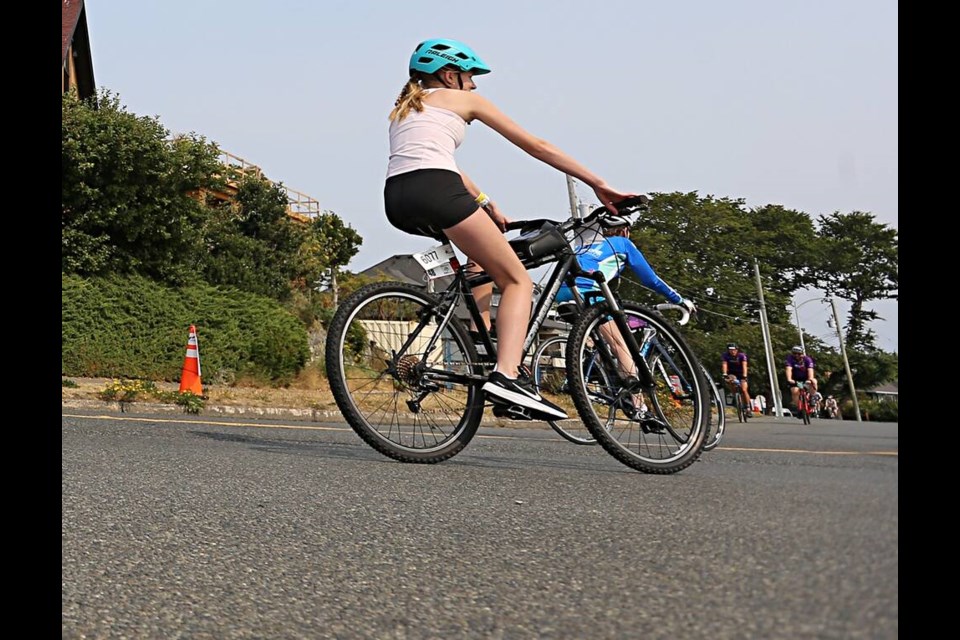We’re pretty good at teaching our kids how to walk across and near streets safely. Most kids I see are wary of traffic and show good street sense. But I feel there’s some more work to do when it comes to kids and bicycle safety.
Three times in the past weeks I’ve seen some very risky biking behaviour, all involving small kids — all in the company of adults.
A man was leading three small kids along a busy stretch of road and wasn’t noticing that his flock was frequently weaving out from beside the curb and into passing traffic.
A woman with two children was riding on one of those urban “mommy machines” — the type equipped with a rear sun hood, flags, tassels and an elongated bench over the rear wheel for the kids to sit on. The children were secure and everyone had helmets on — all good — except for the woman riding one handed because she was on her cellphone.
Then there is my favourite biking pet peeve — a man was following a group of three kids on a fairly quiet street. He was clearly diligent in paying attention as they rode and everyone had a helmet on — except him. That one always blows my mind.
Teaching children good riding habits is essential, especially in our cities. That’s because 56% of all cycling fatalities in this country occur in urban settings.
Dads have to up their game especially. According to the Canadian coroner’s and medical examiner’s database, 6 male cyclist fatalities occur for every female one.
It’s essential that kids are taught good riding habits from day one.
No matter how short the ride, helmets should be worn. This includes putting them on properly. I’ve lost count of how many times I’ve seen small kids dutifully wearing a helmet but placed so badly on the head that it would actually be useless in a crash.
A helmet has to fit to work. There should be no gap between the foam liner and the head. It should fit squarely on the noggin. You want a two-finger space between the front of the helmet and the eyebrows. Have your child open their mouth with the helmet on. If the helmet doesn’t keep hugging their head with the mouth open, the straps are too loose.
Clothing wise, it’s not just about helmets and safety vests. Make sure there’s no baggy clothing or long shoelaces to be caught in the bike’s front sprocket or chain.
Be predictable to drivers. This includes shoulder checking and signalling, just as they will have to do one day in a car. On narrow roads or pathways let pedestrians in front know you’re coming.
Until a child is proficient and very street aware it’s a good idea not to ride at night at all.
Keep their bikes in good condition. Make sure that the brakes, in particular, are working. I saw a particularly tragic case for a young guy who suffered permanent brain injury when his tire pump popped loose from its holder on the frame and flew into the spokes of his front wheel flipping him over, head first, onto the roadway.
Always model good behaviour. This includes showing kids that you’re alert to the road and traffic conditions, obeying the rules and showing courtesy to others. Teach particular awareness about the dangers around cars suddenly opening their doors into bike and traffic lanes.
Perhaps most importantly — don’t be a hypocrite. Wear a helmet yourself as you teach kids to be good riders. One in three cyclists killed in crashes in Canada weren’t wearing a helmet. Yes, it’s not a silver bullet, but only 13% of cyclists wearing their helmets became fatalities between 2006 and 2017 in this country.
For small kids, that first bike especially will be regarded as a toy. Proper cycling is a ton of fun and can lead them to a healthy and independent lifestyle. But ensure your kids know that the “toy”is also actually a vehicle — and with that comes responsibility. They need to think safety first and follow the rules.
Glove Box: Ruth wrote last week, anxious about what she’s seeing as children and adults walk to school. Many times she’s seen people walking on narrow roadways, without sidewalks, with their backs to oncoming traffic — in other words on the right hand side of the road.
B.C.’s motor vehicle act says that pedestrians must use a sidewalk if there is one. If there is no sidewalk, a pedestrian must use the extreme left side of the roadway or the shoulder and face approaching traffic. The only exception is you are allowed to walk on the right hand side when you need to solicit a ride in an emergency situation.
>>> To comment on this article, write a letter to the editor: [email protected]



